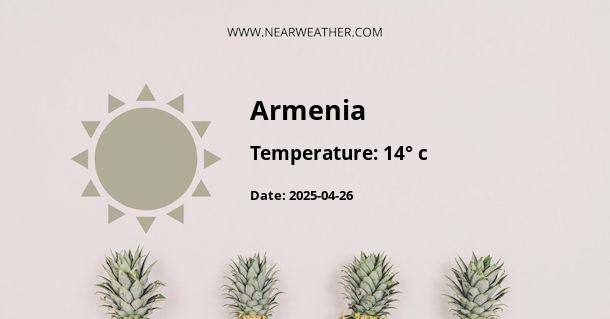Overview of Armenia
The Republic of Armenia is a landlocked country situated in the South Caucasus region of Eurasia. It is bordered by Turkey to the west, Georgia to the north, Azerbaijan to the east, and Iran to the south. The country has a wide range of climatic zones, due to its varied topography and altitude levels, making its weather patterns diverse and unique.
General Climate of Armenia
Armenia is characterized by a highland continental climate, with hot summers and cold winters. It experiences a significant amount of sunshine throughout the year, with the country known as the "sunny country" due to the fact that the sun shines for an average of 2,500 hours annually.
"Armenia has a highland continental climate, with hot summers and cold winters."
Weather by Season
Spring (March to May)
Spring in Armenia begins in mid-March and ends in late May. During this season, the temperature gradually rises, and the weather becomes more predictable. The average temperature ranges from 10 degrees Celsius to 22 degrees Celsius.
Summer (June to August)
The summer season in Armenia is hot and sometimes humid. The average temperature ranges from 25 degrees Celsius to 36 degrees Celsius. The highest temperatures are usually recorded in the Ararat plain, the lowest part of Armenia.
Autumn (September to November)
Autumn in Armenia is considered one of the most beautiful seasons due to the colorful foliage. The weather in this season is quite mild and pleasant, with an average temperature range of 10 degrees Celsius to 25 degrees Celsius.
Winter (December to February)
Winter in Armenia is quite severe, especially in the mountainous regions where there is a significant amount of snowfall. The average temperature in winter ranges from -10 degrees Celsius to 3 degrees Celsius.
"The climate in each season in Armenia varies significantly, with hot summers and cold winters."
Annual Rainfall and Snowfall in Armenia
The average annual rainfall in Armenia is approximately 550 millimeters, with the majority of the rain falling in the spring and early summer. The mountainous regions of the country receive greater amounts of precipitation compared to the lower areas. Armenia receives an average snowfall of 20 to 60 inches annually, with the majority of snow falling in the months of December, January, and February.
Weather Variations Across the Country
Due to Armenia's varied topography and altitude levels, the weather varies significantly across the country. The Ararat plain, the lowest part of the country, experiences the hottest temperatures, while the mountainous regions experience cooler temperatures and more precipitation.
Conclusion
In conclusion, the Republic of Armenia has a diverse climate with a wide range of weather conditions throughout the year. The country's varied topography and altitude levels result in different weather patterns in different regions. Understanding the climate and weather patterns of Armenia can be helpful for residents and tourists alike, for planning various activities and trips.
"Understanding the climate and weather patterns of Armenia can be beneficial for planning various activities and trips."
References
- Armenia Climate Guide, Climatestotravel.com
- Armenia Weather and Climate, Weather-atlas.com
- The Climate of Armenia, Worlddata.info
A - Armenia's Latitude is 40.000000 & Longitude is 45.000000.
A - Weather in Armenia is 14° today.
A - Climate Conditions in Armenia shows broken clouds today.
A - Humidity in Armenia is 39% today.
A - Wind speed in Armenia is 14.22 km/h, flowing at 214° wind direction. today.
